Pink Pacific |
|||||||||||||||||||||||||
 |
 |
||||||||||||||||||||||||
Crocheted top in DROPS Muskat. Piece is crocheted in treble crochets with edge in fan pattern. Size: S - XXXL
DROPS 211-8 |
|||||||||||||||||||||||||
|
---------------------------------------------------------- EXPLANATION FOR THE PATTERN: ---------------------------------------------------------- CROCHET TIP FOR CHAIN STITCHES: If you work at the end of crochet hook the chain stitch will often be too tight. 1 chain stitch should be just as long as 1 double crochet/treble crochet is wide. PATTERN: See diagrams A.1 to A.6. CROCHET INFORMATION (applies to A.1, A.3, A.4 and A.6): At beginning of every row with treble crochets, replace first treble crochet with 3 chain stitches. INCREASE TIP (applies to sides on front piece and back pieces): Increase 1 treble by working 2 trebles in same stitch. DECREASE TIP-1 (applies to armholes): At the beginning of row: Replace number of treble crochets to decrease with 1 slip stitch. At end of row: Do not work over stitches to be decreased. DECREASE TIP-2 (applies to neck): Work 1 treble crochet in each of the next 2 stitches but wait with last yarn over and pull through on both these treble crochets, work 1 treble crochet in the next stitch and pull last yarn over through all 4 loops on hook (= 2 treble crochets decreased). DECREASE TIP-3 (applies to neck): * Make 1 yarn over, insert hook in next stitch, get yarn, make 1 yarn over and pull yarn through the 2 first loops on hook *, repeat from *-* 1 more time, make 1 yarn over and pull yarn through all 3 loops on hook (= 1 treble crochet decreased). ---------------------------------------------------------- START THE PIECE HERE: ---------------------------------------------------------- TOP - SHORT OVERVIEW OF THE PIECE: Piece is worked back and forth in parts. First work front piece and both back piece, bottom up in treble crochets. Then work an edge in fan pattern on front piece and on both back piece, top down. Sew top together on shoulders and in the sides and sew buttons on to back piece. FRONT PIECE: Work 69-75-81-93-99-111 chain stitches on hook size 4 mm with Muskat - read CROCHET TIP FOR CHAIN STITCHES. Turn and work 1 treble crochet in 4th chain stitch from hook (= 2 treble crochets), work 1 treble crochet in every chain stitch the rest of row = 67-73-79-91-97-109 treble crochets on row. Read CROCHET INFORMATION and work in the A.1 to A.3 as follows: Work A.1 over the first stitch, work A.2 until 1 stitch remains on row, finish with A.3 over the last stitch. Continue pattern back and forth like this. REMEMBER THE CROCHET TENSION! AT THE SAME TIME when piece measures 4-3-3-3-3-3 cm, increase 1 treble crochet in each side – read INCREASE TIP. Increase like this every 4-3-3-3-3-3 cm 2-3-3-3-4-4 times in each side = 71-79-85-97-105-117 treble crochets. When piece measures 11-12-13-14-15-16 cm, cast off for armholes in each side – read DECREASE TIP-1 and work as explained below: Continue with treble crochets and decrease for armholes in each side on every row like this: Cast off 3 treble crochets 1-1-1-2-3-5 times, 2 treble crochets 2-3-4-5-5-5 times and 1 treble crochet 2-3-3-3-3-2 times = 53-55-57-59-61-63 treble crochets remain. When piece measures 17-19-20-22-23-25 cm, decrease for neck - read DECREASE TIP-2 and DECREASE TIP-3 and work as explained below: Work shoulder over the first 19-20-20-21-21-22 treble crochets on row (there should be 15-15-17-17-19-19 treble crochets in the middle for neck). Then decrease 2 treble crochets on every row towards the neck 3 times in total, and 1 treble crochet on every row towards the neck 3 times in total = 10-11-11-12-12-13 treble crochets remain on shoulder. Continue to work until piece measures 27-29-31-33-35-37 cm. Cut and fasten the yarn. Work the other shoulder the same way. LEFT BACK PIECE (when garment is worn): Work 40-45-46-52-57-63 chain stitches on hook size 4 mm with Muskat. Turn and work 1 treble crochet in 4th chain stitch from hook (= 2 treble crochets), work 1 treble crochet in every chain stitch the rest of row = 38-43-44-50-55-61 treble crochets on row. Then work A.1 to A.3 as follows: Work A.1 over the first stitch, work A.2 until 1 stitch remains on row, finish with A.3 over the last stitch. Continue pattern back and forth like this. AT THE SAME TIME when piece measures 4-3-3-3-3-3 cm, increase 1 treble crochet in the side – remember INCREASE TIP. Increase like this every 4-3-3-3-3-3 cm 2-3-3-3-4-4 times in the side = 40-46-47-53-59-65 treble crochets. When piece measures 11-12-13-14-15-16 cm, cast off for armholes in the side – read DECREASE TIP-1 and work as explained below: Continue with treble crochets and decrease for armholes in the side on every row like this: Decrease 3 treble crochets 1-1-1-2-3-5 times, 2 treble crochets 2-3-4-5-5-5 times and 1 treble crochet 2-3-3-3-3-2 times = 31-34-33-34-37-38 treble crochets. When piece measures 19-21-22-24-25-27 cm, decrease for neck - read DECREASE TIP-2 and DECREASE TIP-3 and work as explained below: Work shoulder over the first 19-20-20-21-21-22 treble crochets from the side (there should be 12-14-13-13-16-16 treble crochets for neck towards mid front). Then decrease 2 treble crochets on every row towards the neck 3 times in total, and 1 treble crochet on every row towards the neck 3 times in total = 10-11-11-12-12-13 treble crochets remain on shoulder. Continue to work until piece measures 27-29-31-33-35-37 cm. Cut and fasten the yarn. RIGHT BACK PIECE (when garment is worn): Work the same way as left back piece, but make sure that increases in the side, decrease for armhole and decrease for neck is in the opposite side to left back piece. EDGE WITH FAN PATTERN ON FRONT PIECE: Work edge top down. Begin from wrong side and work 1 double crochet in every chain stitch cast on at the bottom of front piece = 67-73-79-91-97-109 double crochets. Then work A.4 to A.6 as follows: Work A.4 over the first 7 stitches, work A.5 until 6 stitches remain on row (= 9-10-11-13-14-16 repetitions of 6 stitches), and finish with A.6 over last 6 stitches. Continue pattern back and forth for 9 cm, adjust after a row from right side. Cut and fasten the yarn. Front piece measures approx. 36-38-40-42-44-46 cm from top and down. EDGE WITH FAN PATTERN ON LEFT BACK PIECE: Work edge top down. Begin from wrong side (i.e. from mid front) and work 1 double crochet in every chain stitch cast on at the bottom of left back piece = 38-43-44-50-55-61 double crochets. Then work A.4 to A.6 as follows from right side (i.e. from the side): Work A.4 over the first 7 stitches, work A.5 until 13-12-13-13-12-12 stitches remain on row (= 3-4-4-5-6-7 repetitions of 6 stitches), work A.6 over the next 6 stitches, and finish with 1 treble crochet in each of the 7-6-7-7-6-6 last stitches (= band). Continue pattern back and forth for 9 cm, adjust after a row from right side. Cut and fasten the yarn. Back piece measures approx. 36-38-40-42-44-46 cm from top and down. EDGE WITH FAN PATTERN ON RIGHT BACK PIECE: Work edge top down. Begin from wrong side (i.e. from the side) and work 1 double crochet in every chain stitch cast on at the bottom of right back piece = 38-43-44-50-55-61 double crochets. Then work A.4 to A.6 as follows from right side (i.e. from mid back): Work 1 treble crochet in each of the first 7-6-7-7-6-6 stitches (= band), work A.4 over the next 7 stitches, work A.5 until 6 stitches remain on row (= 3-4-4-5-6-7 repetitions of 6 stitches), and finish with A.6 over last 6 stitches. Continue pattern back and forth for 9 cm, adjust after a row from right side. Cut and fasten the yarn. Back piece measures approx. 36-38-40-42-44-46 cm from top and down. ASSEMBLY: Sew the shoulder seams edge to edge with neat little stitches. Sew side seams the same way. Sew 5-5-5-6-6-6 buttons evenly onto band on right back piece - top button should be approx. 1 cm from neck edge and bottom button approx. 2 cm from bottom edge, button between treble crochets on left band. |
|||||||||||||||||||||||||
Diagram explanations |
|||||||||||||||||||||||||
|
|||||||||||||||||||||||||
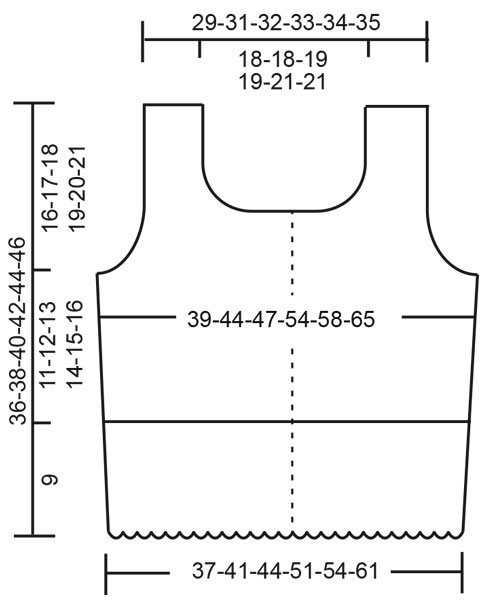
|
|||||||||||||||||||||||||

|
|||||||||||||||||||||||||
|
Have you made this or any other of our designs? Tag your pictures in social media with #dropsdesign so we can see them! Do you need help with this pattern?You'll find tutorial videos, a Comments/Questions area and more by visiting the pattern on garnstudio.com. © 1982-2024 DROPS Design A/S. We reserve all rights. This document, including all its sub-sections, has copyrights. Read more about what you can do with our patterns at the bottom of each pattern on our site. |
|||||||||||||||||||||||||











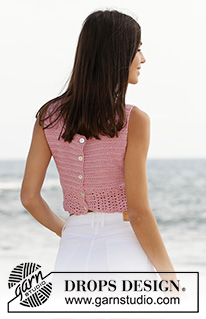
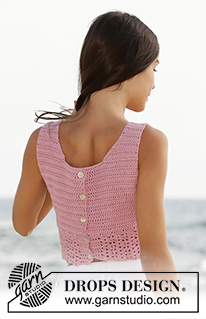















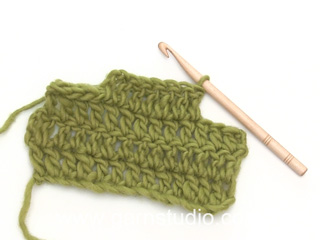


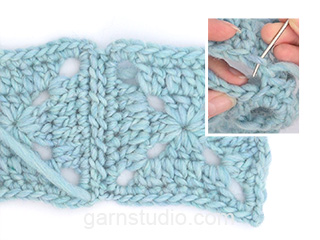

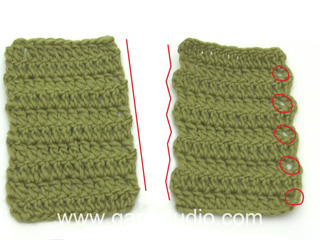























Comments / Questions (10)
Er der ikke et billede af ryggen nogen steder?
24.02.2024 - 23:47DROPS Design answered:
Hej Diana, vi skal se efter, hvis vi har så skal vi nok lægge det ud :)
01.03.2024 - 14:29Bonjour, Pour le modèle 211-8 qu'entendez -vous par 'ajuster après un rang sur l'endroit ' Merci pour votre réponse.
20.06.2023 - 14:50DROPS Design answered:
Bonjour Angèle, ajustez la hauteur indiquée pour votre taille de sorte que le dernier rang tricoté soit un rang sur l'endroit, autrement dit, tricotez les côtes sur un peu moins ou un peu plus de 9 cm en fonction de votre propre tension, tant que le dernier rang est un rang sur l'endroit. Bon crochet!
20.06.2023 - 15:34Ik snap niet veel van dit patroon ik heb de eerste toer gedaan maar hoe dan.
09.06.2023 - 13:52DROPS Design answered:
Dag Bianca,
Na de eerste toer begin je met de telpatronen. Je haakt eerst A.1 over de eerste steek, dat is dus 3 lossen omdat het op het begin van de toer is. Vervolgens haak je A.2, waarbij je het telpatroon dus steeds in de breedte herhaalt totdat je nog 1 steek over hebt op de toer. Deze haak je in A.3. De telpatronen lees je van onder naar boven en van rechts naar links. De toer met een ster ernaast haak je niet.
Voor meer informatie kun je ook de video's bekijken en de stap voor stap instructies lezen over de verschillende technieken die in dit patroon gebruikt worden.
10.06.2023 - 18:26Buongiorno, è possibile avere lo stesso modello lavorato ai ferri? Grazie
16.05.2022 - 14:43DROPS Design answered:
Buonasera Claudia, questo modello è stato progettato per essere lavorato all'uncinetto, non può essere trasformato in un modello ai ferri. Provi a navigare tra i modelli del nostro sito per trovarne tanti altri lavorati ai ferri. Buon lavoro!
17.05.2022 - 18:59Hola se podría hacer este top en dos piezas para no tener que ponerle botones. Habría que hacer dos piezas iguales siguiendo el patrón del delantero y coser??. Gracias
16.04.2022 - 08:32DROPS Design answered:
Hola Raquel, se pueden hacer 2 piezas (delantero y espalda) y coser. Se trabaja igual hasta el escote y la línea del escote se comienza 2 cm antes que la línea del escote en la espalda.
17.04.2022 - 11:56Is de werkbeschrijving die hier staat wel de beschrijving van de top op de foto? Ik zie geen top in 3 kleuren op de foto en ook geen strikbanden.
05.06.2020 - 11:22DROPS Design answered:
Dag Marian,
Patroon en afbeelding waren inderdaad foutief aan elkaar gekoppeld. Het staat nu goed. Dankjewel voor het doorgeven. Veel haakplezier!
08.06.2020 - 12:51Hoi leuk topje. Maar de beschrijving klopt niet met het plaatje. Andere kleur garen, oké Maar driehoeken maken en een strikbandje?? Maar de patronen zijn erg leuk!
02.06.2020 - 21:29Ik denk dat het plaatje niet klopt bij het patroon want die geeft 3 kleuren aan. Ook mis ik hoeveel steken ik moet opzetten. Er staan strikbanden in die op punt a en d vast gemaakt moeten worden maar deze kan ik ook niet herleiden. Lees ik niet goed of zit er een fout in het patroon?
02.06.2020 - 21:22DROPS Design answered:
Dag Marlies,
Oeps... inderdaad het verkeerde patroon bij het plaatje. Dank voor het doorgeven, het is nu aangepast.
05.06.2020 - 12:33Mooi topje ,is het patroon beschikbaar?
18.02.2020 - 09:56Iets langer maar ik zou het model graag haken.
11.01.2020 - 12:54